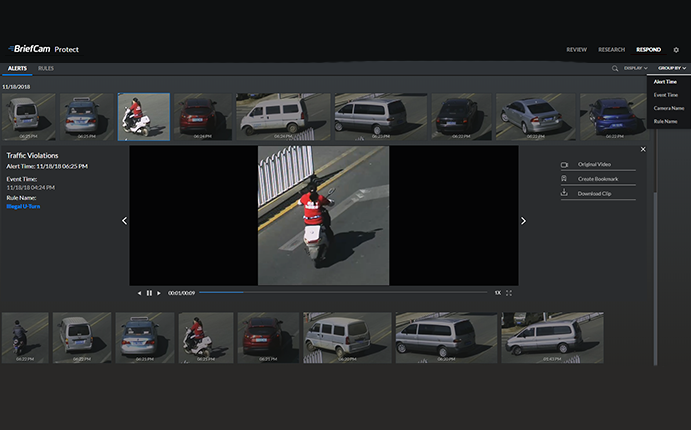Combatting Campus-wide Crime – 8 Intelligent Alerts for Proactive Prevention

Security is a major concern at educational institutions. From K-12 schools to sprawling university campuses and beyond, it is critical to have full situational awareness to enable swift and effective response to incidents and proactive prevention of crime. Intelligent alerting is a key capability for informing campus law enforcement of public safety risks and events and for streamlining campus-wide monitoring.
Driven by artificial intelligence and machine learning technologies, advanced alerting solutions rely on data-driven analytics that extract data from multiple sources, identify detected objects, classify them and index them. The metadata can be leveraged for enhancing security coverage, deriving operational insights and assessing and responding to threats based on intelligent alerting.
The ability to detect dwelling, crowding or movement is key for proactive security – here are 8 intelligent alerts that can be leveraged to drive public safety in campus environments:
Alert Rule: Trigger an alert for dwelling in the parking lot after school hours
For K-12 schools, especially, it is unusual for people or vehicles to dwell in a campus parking lot after hours. Such activity could suggest drug sales or gang activity. By automating alerts for movement and dwelling in the parking lot during predefined hours, school security can evaluate the activity and determine whether something malicious is afoot. Specific alerts can even be customized based on gang colors – triggering calls to action for people wearing colors associated with known gangs that appear in the parking lot at irregular times. This capability enables campus police to quickly surveil and understand the scene before responding.
Alert Rule: Trigger an alert for extended dwelling in the parking lot during drop off and pick up
With intelligent analytics, schools can streamline the monitoring of parking lot activity, including the student pick up and drop off process. Alerting security to excessive dwelling or unrecognized vehicles, this technology increases public safety by enabling security to quickly assess unusual and suspicious behavior, investigate as needed and ensure the safety of all students and staff.
Alert Rule: Trigger dwelling alerts to detect homeless hangouts
College campuses often attract homeless individuals looking for a place to settle. By configuring dwelling alerts, campus security can pinpoint homeless encampments and prevent them to increase public safety.
Alert Rule: Trigger dwelling alerts for loitering around dorms and campus facilities that store valuable equipment
Theft is a major problem on university campuses, and law enforcement invests a lot of time and manpower in investigating theft cases post event. Campus safety experts note that hanging around dorm entryways, bike racks and facilities that store valuable equipment often indicates intent to commit a crime. Dwelling detection helps campus police identify signs of potential crime, so that police can be quickly mobilized to deter or proactively respond to activity.
Alert Rule: Trigger an alert for overcrowding to prevent bottlenecks
Beyond dwelling, video analytics alerts can be used to detect and mitigate overcrowding and traffic bottlenecks. Often, crowding in school hallways increases the potential for violence to erupt or the outbreak of a fight. The ability to monitor hallway throughput and receive immediate alerts when crowds form is a gamechanger for on-site security. On college campuses, where politically motivated gatherings can spark violence, police can more closely track activity and react if there is an indication of escalating risk.
Alert Rule: Trigger an alert for movement on K-12 campuses during class time
During the school day, K-12 security can be alerted to movement during class time to quickly understand whether students are cutting class. Alerts can be made more specific to trigger calls to action for adult movement, drawing security’s attention to assess whether the adult is a recognized parent or staff member, or whether it is a potentially dangerous visitor. This helps security stay ahead of attempts to commit egregious crimes ranging from kidnapping to violence or sexual misconduct.
As active shooter situations continue to terrorize universities and day schools, the ability to immediately detect anomalous activity, attain situational awareness and respond to threats is critical.
Alert Rule: Trigger an alert to track and prevent traffic violations
Alerting can also be configured to protect students and visitors around the campus perimeter or – on large university campuses – on inter-campus roads. Although traffic rules and speed limits are often stricter in the areas surrounding schools, drivers and pedestrians do not always comply with local laws, leading to tragic accidents. By configuring alerts to track traffic violations, campus security can support local law enforcement and ensure the safety of the students arriving at school or navigating the campus.
For instance, if drivers frequently make illegal U-turns in the area of the school, an alert can be triggered to mobilize security. Similarly, when pedestrians cross streets in areas without crosswalks, an alert can be triggered. By tracking these types of infractions leveraging streets within view of campus surveillance cameras, video analytics help security can uncover where traffic guards are needed to prevent accidents and deter misconduct, where crosswalks could be added and other key traffic optimization insights.
While usually harmless, sometimes movement, dwelling, and overcrowding on a campus can indicate potential threats. By bringing the most relevant details to the fore, analytics-backed alerts keep security focused and responsive. With the addition of artificial intelligence and data-driven analytics, campus security personnel can enhance situational awareness, detect unusual and excessive loitering and accelerate responses to emergencies, threats and suspicious behavior.